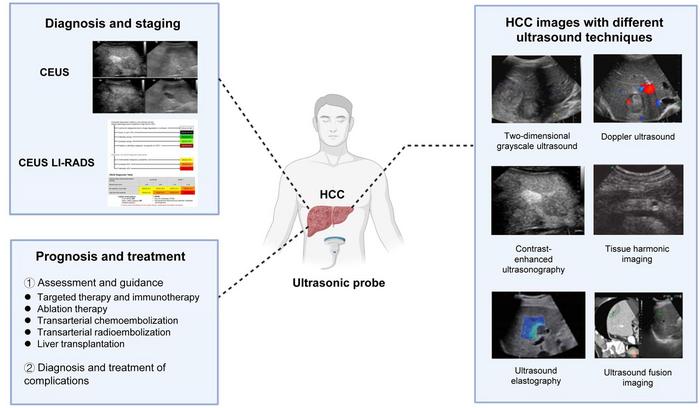Hepatocellular carcinoma (HCC) is a primary malignancy of the liver and one of the leading causes of cancer-related deaths worldwide. Early detection and accurate diagnosis are crucial for effective management and improved survival rates. Ultrasound (US) technology has significantly advanced and plays a pivotal role in the surveillance, diagnosis, and treatment of HCC. This paper delves into various ultrasound techniques and their clinical applications in HCC management.

Credit: Pintong Huang, Huisen Hu, Yonglei Zhao
Hepatocellular carcinoma (HCC) is a primary malignancy of the liver and one of the leading causes of cancer-related deaths worldwide. Early detection and accurate diagnosis are crucial for effective management and improved survival rates. Ultrasound (US) technology has significantly advanced and plays a pivotal role in the surveillance, diagnosis, and treatment of HCC. This paper delves into various ultrasound techniques and their clinical applications in HCC management.
Two-dimensional gray-scale ultrasound is a fundamental imaging technique for HCC surveillance. It is widely used due to its non-invasive nature, cost-effectiveness, and convenience. This technique provides real-time images of the liver, enabling the detection of liver nodules and other structural abnormalities. Regular monitoring with gray-scale ultrasound is recommended for high-risk patients, including those with cirrhosis, chronic hepatitis B or C infections, and a family history of HCC. Studies have shown that consistent surveillance can lead to early detection of HCC, which is associated with a significant survival benefit.
Doppler ultrasound techniques, including color Doppler flow imaging, color Doppler energy, and advanced modes like super microvascular imaging, are essential for evaluating the vascular characteristics of HCC. These methods visualize blood flow within the tumor and its periphery, aiding in the assessment of tumor vascularity and invasion. Color Doppler ultrasound provides critical information for therapeutic decisions, such as identifying suitable vessels for transarterial chemoembolization (TACE).
Contrast-enhanced ultrasound (CEUS) represents a significant advancement in liver imaging. By administering contrast agents, CEUS enhances the visualization of blood flow and tissue perfusion in liver lesions. This technique is instrumental in the preoperative diagnosis, guided biopsy, intraoperative navigation, and post-treatment monitoring of HCC. CEUS is preferred over traditional imaging modalities due to its superior accuracy and lack of radiation exposure. Additionally, three-dimensional CEUS (3D-CEUS) provides detailed spatial visualization of tumor vascularity, further improving diagnostic precision.
Tissue harmonic imaging enhances the quality of ultrasound images by utilizing harmonic frequencies generated by tissue interaction with ultrasound waves. This technique improves the resolution and contrast of images, making it easier to distinguish between HCC and benign liver lesions. Tissue harmonic imaging is particularly useful in patients with fatty liver disease or other conditions that degrade conventional ultrasound image quality.
Ultrasound elastography measures tissue stiffness, providing additional diagnostic information about liver lesions. It is particularly effective in distinguishing between benign and malignant tumors, as HCC typically exhibits increased stiffness compared to surrounding liver tissue. Elastography can be integrated with other ultrasound techniques to enhance the accuracy of HCC diagnosis and monitor the response to treatment.
Ultrasound fusion imaging combines real-time ultrasound with other imaging modalities like CT or MRI, allowing for synchronized and correlated images. This technique offers a comprehensive view of the liver, integrating structural and functional information. Ultrasound fusion imaging is beneficial for precise localization and characterization of liver lesions, guiding biopsies, and planning therapeutic interventions. The ability to display multiplanar reconstruction images on a single screen facilitates quicker and more accurate clinical decision-making.
Ultrasound is the cornerstone of HCC surveillance programs. Regular ultrasound screening in high-risk populations, such as patients with cirrhosis or chronic viral hepatitis, significantly reduces mortality by enabling early detection and timely treatment of HCC. The sensitivity and specificity of ultrasound for HCC detection vary depending on the patient’s risk factors, the operator’s expertise, and the quality of the equipment used. Continuous advancements in ultrasound technology aim to improve the effectiveness of HCC surveillance and ultimately enhance patient outcomes.
Advancements in ultrasound technology have revolutionized the diagnosis and management of hepatocellular carcinoma. Techniques such as two-dimensional gray-scale ultrasound, Doppler ultrasound, contrast-enhanced ultrasound, tissue harmonic imaging, ultrasound elastography, and ultrasound fusion imaging each offer unique advantages that enhance the detection, characterization, and treatment of HCC. Continued research and development in these areas hold promise for further improving the accuracy and efficacy of HCC management, ultimately leading to better patient outcomes.
Full text
The study was recently published in the Journal of Clinical and Translational Hepatology.
The Journal of Clinical and Translational Hepatology (JCTH) is owned by the Second Affiliated Hospital of Chongqing Medical University and published by XIA & HE Publishing Inc. JCTH publishes high quality, peer reviewed studies in the translational and clinical human health sciences of liver diseases. JCTH has established high standards for publication of original research, which are characterized by a study’s novelty, quality, and ethical conduct in the scientific process as well as in the communication of the research findings. Each issue includes articles by leading authorities on topics in hepatology that are germane to the most current challenges in the field. Special features include reports on the latest advances in drug development and technology that are relevant to liver diseases. Regular features of JCTH also include editorials, correspondences and invited commentaries on rapidly progressing areas in hepatology. All articles published by JCTH, both solicited and unsolicited, must pass our rigorous peer review process.
Follow us on X: @xiahepublishing
Follow us on LinkedIn: Xia & He Publishing Inc.
Journal
Journal of Clinical and Translational Hepatology
Article Title
Ultrasonography of Hepatocellular Carcinoma: From Diagnosis to Prognosis
Article Publication Date
30-Apr-2024



